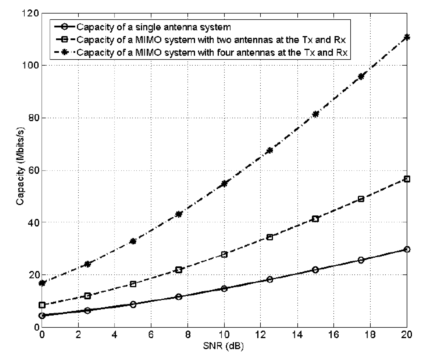|
Embedded NxN MIMO Base Station - Our Core Technology for P2P, P2mP Wireless Embedded Solution
MIMO Wireless Technology
In a MIMO system, the use of multiple antennas at the transmitter and receiver introduces spatial degrees of freedom that can increase the capacity and lower bit error rates. It has been shown that the capacity of a MIMO system increases linearly with the minimum number of antennas at the transmit and receive sides, in a scattering-rich environment5, as shown for a single-user scenario (i.e. a point to point communication link). Most practical environments, however, always display some degree of spatial correlation that degrades the capacity gains obtained using MIMO.
MIMO transmission strategies can be broadly classified into diversity and spatial multiplexing. While diversity aims to lower the probability of error and thereby improve the reliability of the communication link, spatial multiplexing is used to increase the achievable data rates.
1) Diversity: Error probability is reduced by sending multiple copies of the signal over each of the transmit antennas. These signals are coherently combined at the receiver to obtain a stronger signal.

Example Illustration of Diversity-Based Transmission for a 2 x 2 MIMO system,
where extendable to a N x N MIMO Solution.
In the Figure above, where two separately coded versions of the same signal are transmitted over each of the two transmit antennas. Eigenmode Beamforming, which involves transmitting a signal across the strongest spatial channel, is also a diversity-based transmission strategy.
2) Spatial multiplexing: Independent data streams are sent over each of the transmit antennas to increase the data rate of the system. Multiple antennas are used to receive these signals that are then decoded using digital signal processing techniques. This is illustrated in figure below.

Figure illustrate Spatial Multiplexing for a 2 x 2 MIMO system,
where could be extending to N x N MIMO Solution.
MIMO transmission strategies can also be classified as open-loop and closed-loop. In open-loop strategies, the transmitter does not have any knowledge of the channel and transmission follows a deterministic pattern that is independent of the channel. Open-loop transmission strategies include spatial multiplexing and diversity schemes like space time block codes, cyclic delay diversity etc. Closed loop schemes require knowledge of the channel at the transmitter to adapt the transmitted signal to the channel. Precoding is a popular closed-loop MIMO transmission strategy. In this paper, we analyze the performance of the MIMO base station antenna designs using a closed-loop technique known as Grassmannian precoding that is adopted in the IEEE 802.16e standard.

Figure illustrate Comparison Results of MIMO Streaming and Single Antenna Communication
|